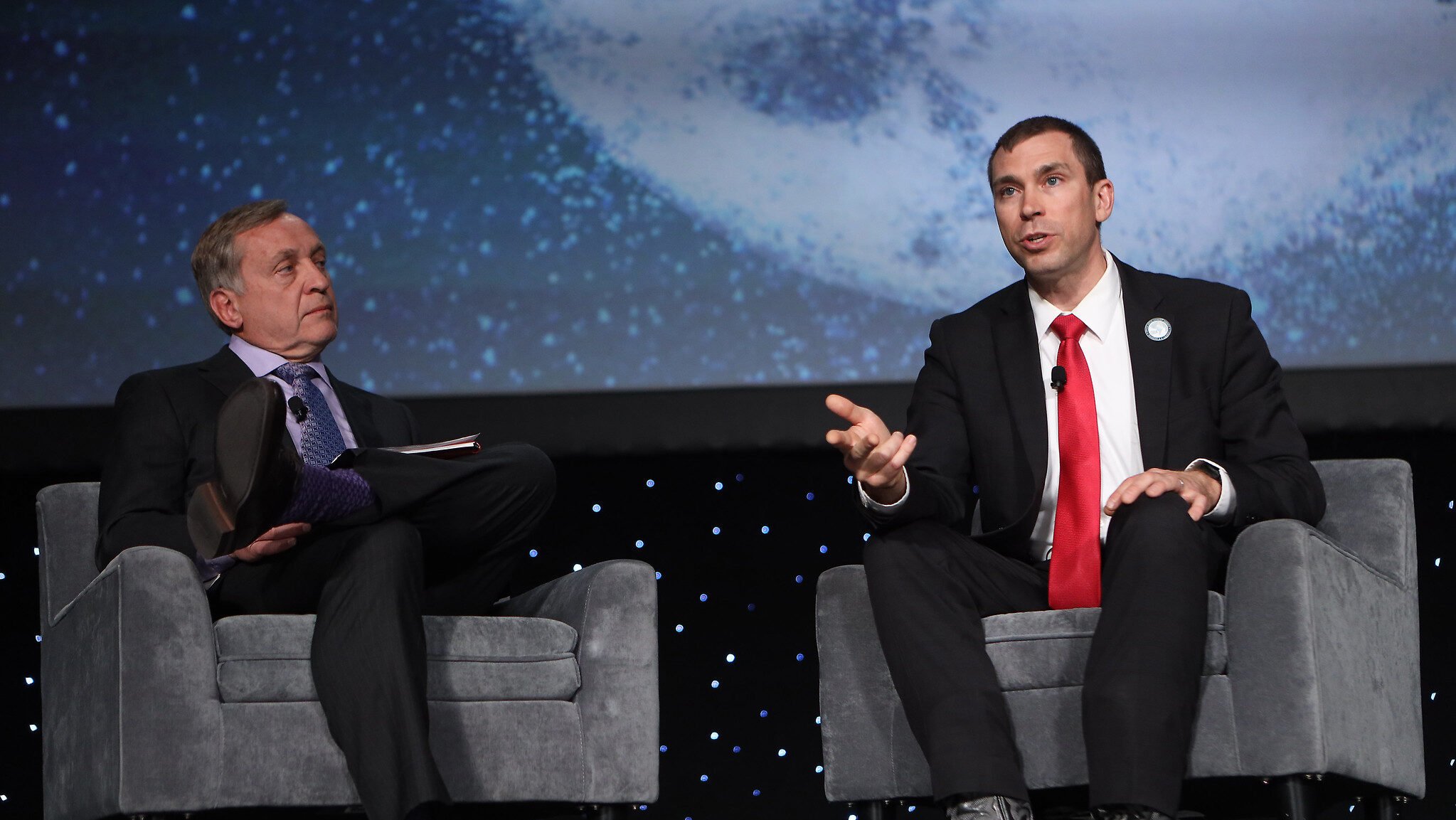
Space Development Agency chief Derek Tournear (R) addresses the audience at the Space Foundation’s 2024 Space Symposium. (Space Foundation)
SPACE SYMPOSIUM 2024 — The Space Force’s Space Development Agency plans to put a new radio-frequency antenna in Norway to communicate with satellites in its forthcoming low-Earth orbit constellation, according to SDA Director Derek Tournear.
The “big RF antenna,” Tournear told reporters on Wednesday following remarks at the Space Symposium conference in Colorado Springs, will be located in Norway’s northern territory.
“The main advantage of that is it gives us good polar coverage for our satellites. All of our Tranche 1 satellites are in polar orbit,” he explained.
Tranche 1 satellites refer to SDA’s second group of LEO birds that are set to start launching later this year, with the first group known as Tranche 0 all sent up as of February. SDA’s tranches, collectively dubbed the Proliferated Warfighter Space Architecture (PWSA), will perform two chief functions. One collection of satellites, known as the tracking layer, will provide missile warning and tracking, whereas a separate transport layer is envisioned to connect sensors and shooters around the globe as the backbone of the Pentagon’s sprawling Joint All Domain Command and Control (JADC2) initiative.
A key issue with the transport layer has been the testing of Link 16, a tactical data link widely used by the US and NATO allies. Federal Aviation Administration restrictions are currently preventing SDA from conducting Link 16 testing over US soil, so SDA has turned to an unnamed partner in the Five Eyes intelligence alliance for that work. And now, in addition to the RF antenna, Norway will also host new tests for an SDA Link 16 demo sometime this summer, Tournear revealed.
“We’ll be demonstrating Link 16 from space directly into their territory to their platforms,” he said. “On their aircraft and their ground units, they’ll be able to talk directly to us with Link 16 to our Tranche 0 satellites that are on orbit now.”
Lockheed Martin and York Space Systems each delivered 10 satellites to SDA for Tranche 0’s transport layer, and of those, three from each vendor have Link 16 capability. Those satellites are envisioned to enable a mesh network — the ability to talk between each other in space — for all the Tranche 0 transport layer birds, which Tournear said SDA plans to field by the summer.
Meanwhile, the military services are looking to tap into the PWSA and other satellite systems by developing special “hybrid” SATCOM terminals that can switch between commercial and military constellations, which Tournear called the “Space Force’s vision for how to do SATCOM terminals in the future” if they work as hoped.
“The plan is, I have my one box that talks to all of the constellations and I can switch, eventually autonomously, between them based on what you have overhead. That’s what gives you resilience and it also allows our partner services to all be able to make sure that, ‘if I have this box on my platform, I know I can get SATCOM,’” he said.
The Air Force’s version of that effort is called Global Lightning, the Navy has a similar program called Sting, while the Army is watching both efforts to inform its own future plans, according to Tournear. Vendors building Global Lightning terminals are contracted to connect to SDA’s military Ka band for the transport layer, Tournear said, and should have the capability to connect with SpaceX’s Starshield constellation and possibly others. “Sting is following a similar model,” he added.
Looking ahead, Tournear said a shift is planned for Tranche 3 satellites. The tracking satellites will be “pretty straightforward,” with a notional number of 54 being planned for launch depending on budget considerations. The transport satellites, however, will see a “shifting from Link 16,” he said.
Since hundreds of Link 16 satellites will be fielded between Tranche 1 and Tranche 2, Tournear said SDA will have “very good coverage for the Link 16 mission.” Some additional Link 16 satellites might be sent up in Tranche 3 “to help with resiliency,” he noted, but the “big debate” now is what the next tactical data links will be “proliferated.”
For Tranche 2, SDA plans for Ultra-High Frequency and S-band connectivity for tactical SATCOM, or communication for specific platforms. “What we do on Tranche 3 is being informed by what radios those platforms are actually planning on flying in that timeframe,” Tournear explained. “It most likely will be S band,” he said, though “the specific waveforms are still TBD.”
In the near term, with SDA planning to launch its Tranche 1 sats later this year — which will be the first operational PWSA birds — the ground segment will need to be ready first. Getting ground in place before launch, a task in this case handled by contractors General Dynamics and Iridium, has been a key goal of Space Force acquisition chief Frank Calvelli, particularly as crucial constellations like GPS face delays due to trouble with getting a new ground system to work.
According to Tournear, that won’t be an issue for Tranche 1.
“The ground is coming along on schedule,” he said. “We will have ground ready before we launch the satellites, so no issues or concerns there.”






















